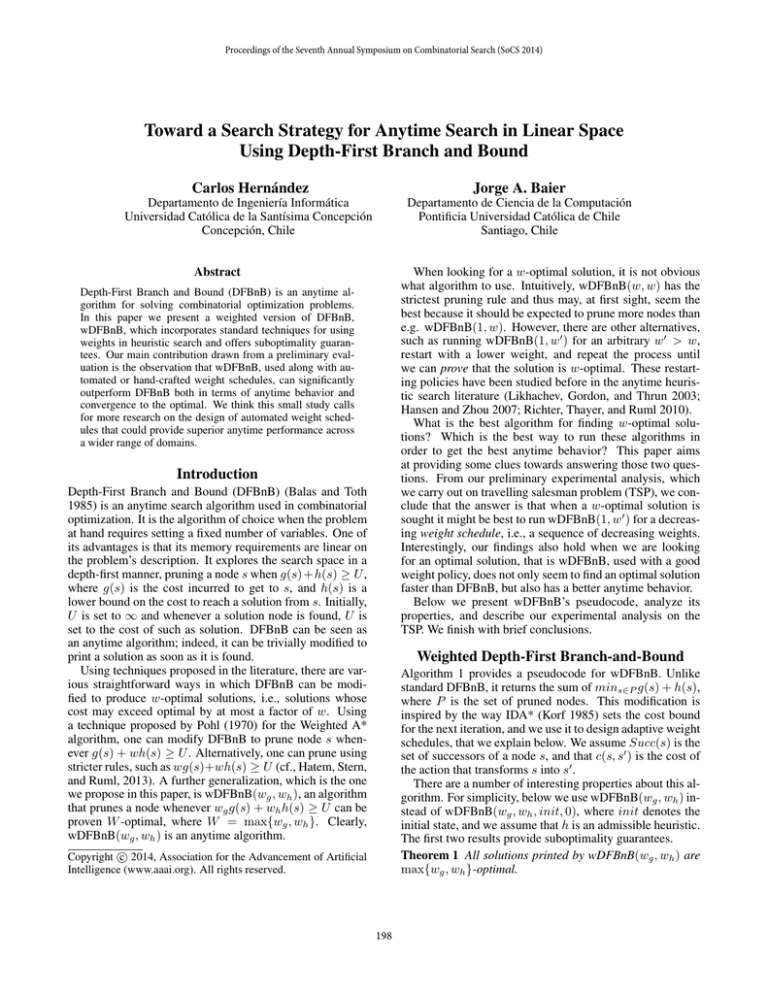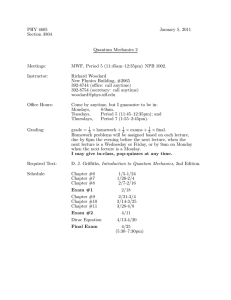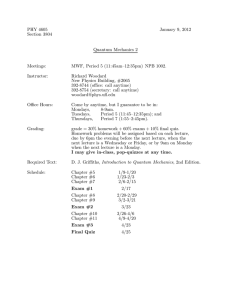
Proceedings of the Seventh Annual Symposium on Combinatorial Search (SoCS 2014)
Toward a Search Strategy for Anytime Search in Linear Space
Using Depth-First Branch and Bound
Carlos Hernández
Jorge A. Baier
Departamento de Ingenierı́a Informática
Universidad Católica de la Santı́sima Concepción
Concepción, Chile
Departamento de Ciencia de la Computación
Pontificia Universidad Católica de Chile
Santiago, Chile
When looking for a w-optimal solution, it is not obvious
what algorithm to use. Intuitively, wDFBnB(w, w) has the
strictest pruning rule and thus may, at first sight, seem the
best because it should be expected to prune more nodes than
e.g. wDFBnB(1, w). However, there are other alternatives,
such as running wDFBnB(1, w0 ) for an arbitrary w0 > w,
restart with a lower weight, and repeat the process until
we can prove that the solution is w-optimal. These restarting policies have been studied before in the anytime heuristic search literature (Likhachev, Gordon, and Thrun 2003;
Hansen and Zhou 2007; Richter, Thayer, and Ruml 2010).
What is the best algorithm for finding w-optimal solutions? Which is the best way to run these algorithms in
order to get the best anytime behavior? This paper aims
at providing some clues towards answering those two questions. From our preliminary experimental analysis, which
we carry out on travelling salesman problem (TSP), we conclude that the answer is that when a w-optimal solution is
sought it might be best to run wDFBnB(1, w0 ) for a decreasing weight schedule, i.e., a sequence of decreasing weights.
Interestingly, our findings also hold when we are looking
for an optimal solution, that is wDFBnB, used with a good
weight policy, does not only seem to find an optimal solution
faster than DFBnB, but also has a better anytime behavior.
Below we present wDFBnB’s pseudocode, analyze its
properties, and describe our experimental analysis on the
TSP. We finish with brief conclusions.
Abstract
Depth-First Branch and Bound (DFBnB) is an anytime algorithm for solving combinatorial optimization problems.
In this paper we present a weighted version of DFBnB,
wDFBnB, which incorporates standard techniques for using
weights in heuristic search and offers suboptimality guarantees. Our main contribution drawn from a preliminary evaluation is the observation that wDFBnB, used along with automated or hand-crafted weight schedules, can significantly
outperform DFBnB both in terms of anytime behavior and
convergence to the optimal. We think this small study calls
for more research on the design of automated weight schedules that could provide superior anytime performance across
a wider range of domains.
Introduction
Depth-First Branch and Bound (DFBnB) (Balas and Toth
1985) is an anytime search algorithm used in combinatorial
optimization. It is the algorithm of choice when the problem
at hand requires setting a fixed number of variables. One of
its advantages is that its memory requirements are linear on
the problem’s description. It explores the search space in a
depth-first manner, pruning a node s when g(s) + h(s) ≥ U ,
where g(s) is the cost incurred to get to s, and h(s) is a
lower bound on the cost to reach a solution from s. Initially,
U is set to ∞ and whenever a solution node is found, U is
set to the cost of such as solution. DFBnB can be seen as
an anytime algorithm; indeed, it can be trivially modified to
print a solution as soon as it is found.
Using techniques proposed in the literature, there are various straightforward ways in which DFBnB can be modified to produce w-optimal solutions, i.e., solutions whose
cost may exceed optimal by at most a factor of w. Using
a technique proposed by Pohl (1970) for the Weighted A*
algorithm, one can modify DFBnB to prune node s whenever g(s) + wh(s) ≥ U . Alternatively, one can prune using
stricter rules, such as wg(s)+wh(s) ≥ U (cf., Hatem, Stern,
and Ruml, 2013). A further generalization, which is the one
we propose in this paper, is wDFBnB(wg , wh ), an algorithm
that prunes a node whenever wg g(s) + wh h(s) ≥ U can be
proven W -optimal, where W = max{wg , wh }. Clearly,
wDFBnB(wg , wh ) is an anytime algorithm.
Weighted Depth-First Branch-and-Bound
Algorithm 1 provides a pseudocode for wDFBnB. Unlike
standard DFBnB, it returns the sum of mins∈P g(s) + h(s),
where P is the set of pruned nodes. This modification is
inspired by the way IDA* (Korf 1985) sets the cost bound
for the next iteration, and we use it to design adaptive weight
schedules, that we explain below. We assume Succ(s) is the
set of successors of a node s, and that c(s, s0 ) is the cost of
the action that transforms s into s0 .
There are a number of interesting properties about this algorithm. For simplicity, below we use wDFBnB(wg , wh ) instead of wDFBnB(wg , wh , init, 0), where init denotes the
initial state, and we assume that h is an admissible heuristic.
The first two results provide suboptimality guarantees.
Theorem 1 All solutions printed by wDFBnB(wg , wh ) are
max{wg , wh }-optimal.
c 2014, Association for the Advancement of Artificial
Copyright Intelligence (www.aaai.org). All rights reserved.
198
Algorithm 1: Weighted Depth-First Branch-and-Bound
1 procedure wDFBnB-Driver(init, wg , wh , wtarget )
2
U ← a provably correct upper bound (i.e., ∞)
3
repeat
4
L ← wDFBnB(wg , wh , init, 0)
5
print “current suboptimality is U/L”
6
hwg , wh i ← getNextWeights()
7
until U/L ≤ wtarget
8 function wDFBnB(wg , wh , s, cost)
9
minf ← ∞
10
if s is a goal node then
11
if cost < U then
12
U ← cost
13
print current solution s and cost
15
16
17
18
19
else
foreach s0 ∈ Succ(s) do
g ← cost + c(s, s0 )
if wg g + wh h(s0 ) ≥ U then
f ← g + h(s0 )
20
21
else
22
if minf > f then minf ← f
23
Figure 1: wDFBnB’s anytime behavior superior to DFBnB
minf ← cost
14
improve with any of the weight schedules. In the 27-city
problem wDFBnB(w, w) requires more than one order of
magnitude more time to converge to the optimal solution
than wDFBnB(1, w).
We observe the anytime behavior of wDFBnB(1, w) is superior to that of DFBnB. Furthermore, in the 27-city problem wDFBnB converges faster to the optimal solution. The
fixed schedule p1 and the adaptive schedule p4 seem to obtain best results.
f = wDFBnB(wg , wh , s0 , g)
return minf
Theorem 2 Let L and sol be respectively the return value
of and the last solution printed by wDFBnB(wg , wh ). Then
sol is (U/L)-optimal.
Summary and Conclusions
We presented wDFBnB an anytime weighted version of DFBnB that allows finding suboptimal solutions with quality
guarantees. Our preliminary evaluation is promising and
supports the fact when looking for an optimal, wDFBnB is
superior to DFBnB both in its anytime behavior and in total
runtime. Our evaluation shows the potential of both handcrafted and automated weight schedules. Automated weight
schedules seem advantageous since they do not need tuning
and might be built automatically by exploiting the structure
of the search space. However, more experimental evidence
across different benchmarks is needed to draw stronger conclusions. Future work will also consider comparing to dovetailing (Valenzano et al. 2010) and other related methods.
The following result establishes that if a strictly decreasing weight policy is used, then we eventually find a wtarget optimal solution.
Theorem 3 Let function getNextWeights be such that it returns a pair hwg0 , wh0 i, such that 1 ≤ max{wg0 , wh0 } <
max{wg , wh }. Then wDFBnB-Driver terminates printing
a wtarget -optimal solution.
Finally, the following theorem sets the basis for implementing adaptive weight schedules that guarantee termination.
Theorem 4 Let wg and wh be such that wg 6= wh , and let L
and sol be respectively the return value of and the last solution printed by the call to wDFBnB in the wDFBnB-Driver
procedure. Then U/L < max{wg , wh }.
In particular Theorem 4 establishes that implementing getNextWeights such that it returns a pair hwg0 , wh0 i that is such
that max{wg0 , wh0 } ≤ U/L, and such that wg0 6= wh0 guarantees termination (and thus wtarget -optimality).
References
Balas, E., and Toth, P. 1985. Branch and Bound Methods. The
Traveling Salesman Problem: A Guided Tour of Combinatorial
Optimization. John Wiley & Sons, Inc.
Hansen, E. A., and Zhou, R. 2007. Anytime heuristic search. JAIR
28:267–297.
Hatem, M.; Stern, R.; and Ruml, W. 2013. Bounded suboptimal
heuristic search in linear space. In Proc. SoCS.
Korf, R. E. 1985. Depth-first iterative-deepening: An optimal
admissible tree search. AIJ 27(1):97–109.
Likhachev, M.; Gordon, G. J.; and Thrun, S. 2003. ARA*: Anytime A* with Provable Bounds on Sub-Optimality. In Proc. NIPS.
Pohl, I. 1970. Heuristic search viewed as path finding in a graph.
AIJ 1(3):193–204.
Richter, S.; Thayer, J. T.; and Ruml, W. 2010. The joy of forgetting:
Faster anytime search via restarting. In Proc. ICAPS, 137–144.
Valenzano, R. A.; Sturtevant, N. R.; Schaeffer, J.; Buro, K.; and
Kishimoto, A. 2010. Simultaneously searching with multiple settings: An alternative to parameter tuning for suboptimal singleagent search algorithms. In Proc. ICAPS, 177–184.
Experimental Evaluation
The objective of our experiments was to evaluate the effect
of different weight schedules on the anytime performance of
wDFBnB(w, w) and wDFBnB(1, w). We used 2 symmetric
TSP instances (27 and 51 cities). We tested 4 weight schedules: two fixed weight schedules and two adaptive weight
schedules based on Theorem 4. Schedule p1 and p2 decrement w by 0.05 and 0.1, respectively. Schedule p3 sets the
next value as w = U/L while p4 sets it to w = .99U/L.
We used 60 seconds as a deadline, and w = 1.5 as an initial
weight. wtarget was set to 1.
Our first observation is that wDFBnB(1, w) is clearly
superior to wDFBnB(w, w).
In the 51-city problem
wDFBnB(w, w) prints only one solution, which it cannot
199





